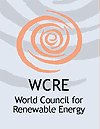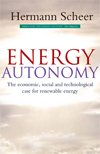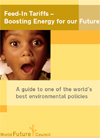Publications
 Article published in EUROSOLAR (Ed.): The City - A Solar Power Station. 6th European Conference Solar Energy in Architecture and Urban Planning, Bonn, September 12th - 15th, 2000
Article published in EUROSOLAR (Ed.): The City - A Solar Power Station. 6th European Conference Solar Energy in Architecture and Urban Planning, Bonn, September 12th - 15th, 2000For as long as in the history of human settlement there were no efficient energy systems, no rapid and large-volume transport capacities and no traffic infrastructure, areas of settlement had to remain directly linked to the areas where energy was generated and food produced. The fields and forest regions that supplied the energy resources for the cities in pre-industrial times had to be some 40 to 100 times larger – depending on soil quality and climatic cultivation conditions – than the actual areas of settlement. For as long as this natural limit to growth was respected, there was little likelihood of supply crises. Economic conditions seldom permitted excessive wealth; yet on the other hand, the only real threat to stability was posed by the effects of wars.
 WCRE paper, August, 2001
WCRE paper, August, 2001
All people are entitled to pursue their desires for a world that is increasing in its bounty, improving in its health, and growing in its capacity to host life. Each person might wish that his or her presence on this Earth will leave it slightly better off than before. Yet the economic progress of the 20th century, based on fossil fuels and nuclear and large-scale hydro power, while advancing human society in many ways, also created a rising threat to those principles.
 Article published in ZNER 2/1998
Article published in ZNER 2/1998 EU Feed-in Directive and Feed-in Legislation for Electricity Generated with Renewable Energy Sources versus Introduction Ratios.
Legal, energy and environmental issues in market access for renewable energy sources
The ongoing debate on the constitutional tenability of Germany's feed-in legislation for electricity generated with renewable energy sources (RES) - i.e. the question of its legality "at bottom" - and the operational or market economy appropriateness of the tariffs it contains - i.e. the question of their legality "in amount" - has reached a new dimension with the now beginning discussions about implementing the EU Commission's White Paper on renewable energy sources (inter alia with the aim of increasing the share of renewables in the EU's energy supply to 12 % by the year 2010) and the recommendation it contains on an EU feed-in directive.
 WCRE paper, July, 2001
WCRE paper, July, 2001
Draft-Statute of the International Renewable Energy Agency (IRENA)
The Contracting Parties shall establish an International Renewable Energy Agency (IRENA), hereinafter referred to as the agency, in accordance with the following provisions and conditions...
 Article published in Scheer, H. / Ghandi, M. / Aitken, D. / Hamakawa, Y. / Palz, W. (Ed.): The Yearbook of Renewable Energies 1995/96: Solar Energy – What are its Driving Forces ?, London, 1995
Article published in Scheer, H. / Ghandi, M. / Aitken, D. / Hamakawa, Y. / Palz, W. (Ed.): The Yearbook of Renewable Energies 1995/96: Solar Energy – What are its Driving Forces ?, London, 1995Introduction
Many people think the question of the share of renewable energies in the energy supply is merely scientific. The truth is: the discussion of the potential of renewable energies is an almost entirely political one. It cannot be seriously denied that there is a natural renewable energy potential sufficient to satisfy forever the energy needs even of an increasing world population. Neither can be denied that there are numerous - already applied - technologies for using this potential. Therefore it is only a question of how many economic and political initiatives for the utilization of renewable energies are input until there is output completely meeting the energy needs.
 WCRE paper, June 13th, 2001
WCRE paper, June 13th, 2001
Draft for a Supplementary Protocol to the Nuclear Non-Proliferation Treaty of July 1st, 1970
The contracting states
- in harmony with the fundamental aims of "Agenda 21", adopted at the United Nations Conference on Environment and Development in 1992 in Rio de Janeiro, championing a sustainable economic and social development consistent with the conservation of natural fundaments of life;
- considering the experience of the Nuclear Non-Proliferation Treaty which took effect on July 1, 1970;
 Article published in Scheer, H. / Ghandi, M. / Aitken, D. / Hamakawa, Y. / Palz, W. (Ed.): The Yearbook of Renewable Energies 1994: Solar Energy – What are its Driving Forces ?, London, 1994
Article published in Scheer, H. / Ghandi, M. / Aitken, D. / Hamakawa, Y. / Palz, W. (Ed.): The Yearbook of Renewable Energies 1994: Solar Energy – What are its Driving Forces ?, London, 1994 Editorial
Future generations will certainly ask why both politics and economics in the 1970s, 1980s, and the beginning of the 1990s of the 20th Century had been acting in such a passive and cowardly way with respect to the far-reaching opportunities of-fered by renewable energies. Therefore, the only open questions are...




 Why a World Council for Renewable Energy? (pdf)
Why a World Council for Renewable Energy? (pdf)